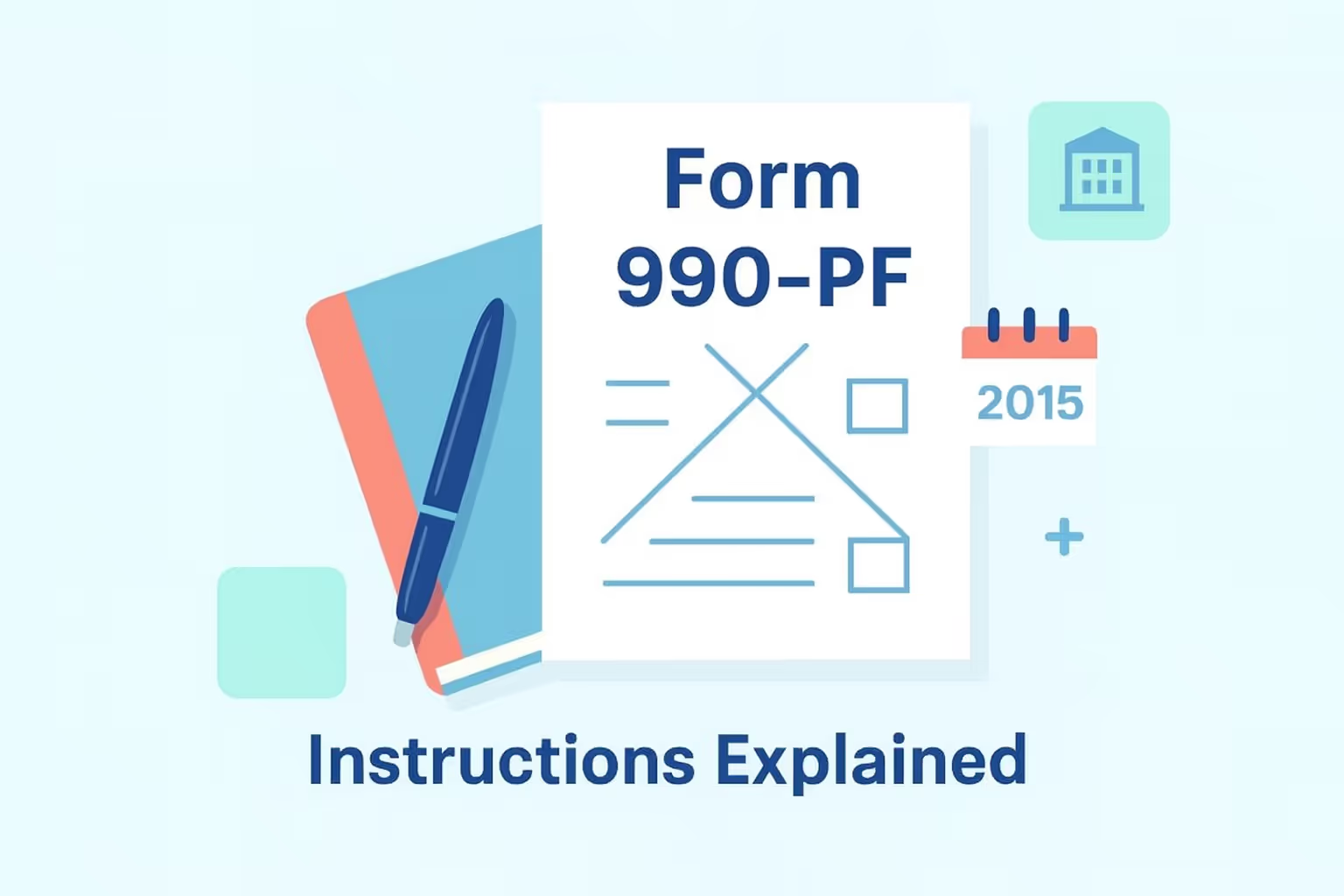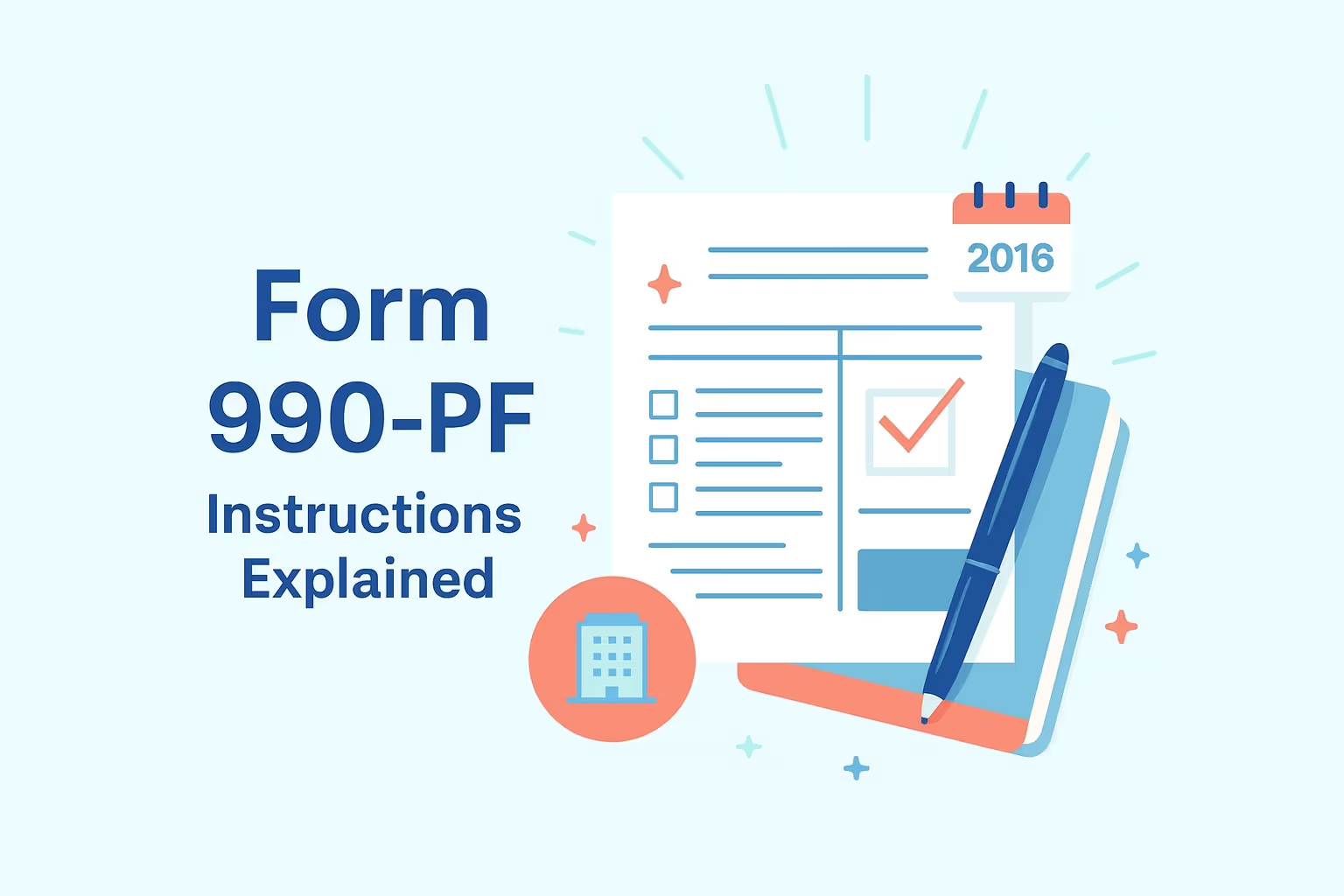Form 990-PF 2012 Instructions for Private Foundations
Private foundations are charitable organizations recognized under the Internal Revenue Code. They must file Form 990-PF each year to maintain their tax-exempt status and report key details about their operations. The filing demonstrates compliance with federal income tax obligations and confirms that all funds are used to support charitable purposes. The filing also fulfills public inspection requirements, enabling donors and the Internal Revenue Service to review how charitable contributions are managed.
Each private foundation, whether exempt or taxable, must disclose information such as fund balance, gross amount of income, professional fees, and donations paid during the year. The return includes details on investment income, unrelated business taxable income, and other items that affect the foundation’s financial position. Accurate filing helps organizations document expenses incurred, demonstrate compliance with the Internal Revenue Code, and avoid complications involving unpaid tax or loss of exempt status.
The IRS provides guidance on preparing and submitting Form 990-PF. According to the official 2012 Instructions for Form 990-PF (IRS Publication), foundations should carefully review each section to ensure accurate reporting of all activities and deductions related to taxable years beginning in 2012. Understanding these requirements helps organizations remain transparent and meet their charitable obligations.
Understanding the Form and Its Components
Form 990-PF requires detailed reporting across multiple sections to ensure complete transparency of a private foundation’s financial activity. Each part serves a specific purpose, helping both the organization and the Internal Revenue Service verify compliance with tax-exempt provisions. Proper completion enables foundations to demonstrate responsible management of charitable contributions and compliance with federal income tax requirements under the Internal Revenue Code.
- Part I – Analysis of Revenue and Expenses: This section reports all sources of revenue, including gross investment income, capital gain net income, net income, and unrelated business income. It also lists all expenses incurred by the foundation, including professional fees, charitable giving, and administrative costs necessary for its daily operations.
- Part II – Balance Sheets: This section details the beginning and ending fund balance, total assets, and liabilities. It reflects the year-end net assets and outlines all changes resulting from contributions, paid donations, or other items that affect the foundation’s overall financial standing.
- Part III – Changes in Net Assets: This section summarizes all increases or decreases in net income over the taxable year. It helps establish a clear picture of the foundation’s growth, distribution activity, and retained resources available for charitable purposes.
- Part IV – Capital Gains and Losses: This section documents transactions involving securities loans, sales, and acquisitions. It ensures accurate calculation of capital gain, net income, and compliance with fair market valuation requirements.
- Part V – Qualification for Reduced Tax: This section determines whether the foundation qualifies for reduced excise tax rates under Internal Revenue Code section 4940(e). It verifies that the foundation’s distributions and expenses meet reasonable thresholds aligned with the standards of charitable organizations.
- Part VI – Excise Tax Based on Investment Income: This section calculates the excise tax using a flat rate applied to net investment income. It requires careful review of deductions and related adjustments to ensure accuracy.
- Parts VII–IX – Activity and Compliance Details: These sections include information about disqualified persons, substantial contributors, and transactions subject to review. They record data on unpaid tax, estimated tax, and compliance with public inspection requirements.
- Parts X–XIII – Distribution Requirements: These sections assess the annual qualifying distributions made for charitable purposes. They ensure compliance with minimum payout rules and confirm the treatment of undistributed income in accordance with IRS standards.
Each section of Form 990-PF contributes to establishing an accurate and verifiable record of financial stewardship. Understanding the structure allows foundations to complete their tax returns with precision and maintain full compliance with federal reporting obligations.
Filing Requirements, Deadlines, and Extensions
Private foundations with tax-exempt status must file Form 990-PF each year to comply with the Internal Revenue Code. The filing confirms that the organization meets reporting standards for charitable organizations and accurately discloses all contributions and distributions. Each return reflects financial activity for taxable years beginning in the covered period and aligns with federal income tax regulations.
Who Must File
Organizations recognized as private foundations under section 501(c)(3) must submit Form 990-PF. This includes both exempt and taxable foundations, as well as certain trusts treated as private foundations. Public charities, as defined under section 509(a), generally use Form 990 or Form 990-EZ instead. Filers must report income tax details, charitable giving, and expenses incurred during the year to preserve their exempt status.
Filing Deadlines
Form 990-PF is due on the fifteenth day of the fifth month after the end of the foundation’s accounting period. Calendar-year filers must submit their return by May 15 of the year following the tax year. If the due date falls on a weekend or a legal holiday, the filing is due on the next business day. Timely filing prevents unpaid tax assessments and preserves eligibility for exemption.
Extension Process
The IRS allows organizations to request more time through Form 8868. The Form 8868, Application for Extension of Time to File, explains how to apply for an automatic three-month extension, with an optional three-month extension if needed. Foundations must still pay any federal income tax balance by the original due date, even when the IRS approves an extension.
Compliance and Reasonable Cause
Late filings without reasonable cause can trigger daily fines based on the foundation’s gross receipts. To request relief, filers must demonstrate reasonable cause and provide supporting records that explain the delay. Maintaining organized documentation enhances any abatement request and supports compliance during an IRS review.
Meeting these filing requirements protects a foundation’s standing as a charitable organization. Establishing a reliable process for reporting, payment, and extension requests ensures continued compliance with federal income tax provisions. Careful attention to deadlines and accurate disclosures is essential for maintaining long-term tax-exempt status.
How to Calculate Net Investment Income
Private foundations must calculate net investment income to determine their excise tax liability under the Internal Revenue Code. This figure represents total investment earnings after deducting allowable expenses incurred in generating income. Accurate computation ensures compliance with federal income tax regulations and supports transparency for tax-exempt organizations.
Net investment income generally encompasses multiple revenue sources collected during taxable years that begin in the reporting period. Each source must be fully documented and reported before deductions are applied. The total should reflect the gross amount received across all qualifying investment activities.
- Interest and Dividends: This category encompasses income generated from bonds, certificates of deposit, and equity investments that yield regular returns for the foundation.
- Capital Gain Net Income: This figure represents the gains realized from the sale or exchange of securities and other property, as recorded during the taxable year.
- Rents and Royalties: This portion records income derived from leasing real property or licensing intangible assets, including trademarks, patents, and other forms of intellectual property.
- Securities Loans: This entry captures revenue earned from lending securities to other parties, including any related fees or compensation received.
- Other Investment Earnings: This item discloses additional amounts received from passive investments or similar arrangements that qualify as investment income.
Organizations must exclude unrelated business income from this calculation. Revenue classified as unrelated business taxable income must be reported separately under the applicable sections of Form 990-PF. Correct categorization prevents misstatements and safeguards the foundation’s tax-exempt status.
Allowable deductions are subtracted from the gross total to determine net investment income. These deductions must directly relate to generating investment revenue and be supported by documentation. Allowable deductible expenses include the following:
- Professional Fees: This deduction includes payments made to advisors, brokers, or accountants who assist the foundation in managing its investments.
- Custodian and Service Charges: This item covers fees associated with maintaining financial accounts and processing investment transactions.
- Administrative Costs: This category represents expenses incurred solely for overseeing investments or managing operations directly tied to investment activities.
All reported deductions must be reasonable, clearly identified, and limited to amounts directly connected to income production. Personal or unrelated costs cannot be deducted from the taxable base under federal income tax rules. Each deduction must include documentation that shows its connection to generating investment income and ensures compliance with Internal Revenue Code standards.
The foundation applies a flat rate of 2 percent, or a reduced rate of 1 percent when eligible, to its net investment income. This amount, recorded in Part VI of Form 990-PF, establishes the excise tax owed for the year. Careful calculations and consistent review of estimated tax obligations ensure accuracy and prevent unpaid balances at the time of filing.
Excise Tax Rules and Capital Gains Reporting
Private foundations use net investment income to calculate the excise tax owed to the Internal Revenue Service. This tax, as outlined in Section 4940 of the Internal Revenue Code, ensures that organizations contribute to the cost of tax oversight. Each foundation must determine its applicable rate and report capital transactions accurately to maintain compliance with federal income tax laws.
The excise tax generally applies to net investment income, including interest, dividends, rents, and capital gains. Some organizations may qualify for a reduced 1 percent rate if they meet specific distribution requirements during the taxable year. Accurate reporting of investment income and deductions supports compliance and helps prevent calculation errors.
Excise Tax Computation
- Most private foundations apply a standard rate of 2 percent to their total net investment income when filing for the taxable year.
- Foundations that meet distribution requirements for the current and preceding years may qualify for a reduced 1 percent rate.
- The excise tax equals the applicable percentage multiplied by total net investment income reported on Form 990-PF.
- All deductions used in the computation must directly relate to investment activities and comply with the Internal Revenue Code.
- Foundations should monitor quarterly estimated tax payments to prevent unpaid tax balances and avoid interest or late fees.
Capital Gains Reporting
- Foundations must include all sales or exchanges of securities, real estate, or other capital assets in their records.
- Fair market values on transaction dates must be used to determine realized gains or losses for the taxable year.
- Foundations must retain records such as brokerage statements, confirmations, and supporting documentation for each reported transaction.
- Foundations must reflect adjustments for prior-year losses and any applicable carryovers in the current computation of taxable income.
IRS Publication 598, Tax on Unrelated Business Income of Exempt Organizations, explains how exempt organizations should report unrelated business taxable income alongside investment earnings. By following excise tax and capital gain reporting standards, foundations demonstrate accurate accounting, protect tax-exempt status, and maintain compliance with federal requirements.
Reporting Fair Market Value and Asset Information
Private foundations must accurately report their asset values to comply with federal income tax requirements and maintain transparency in accordance with the Internal Revenue Code. Proper valuation ensures that financial statements reflect actual economic conditions and that calculations for fund balance, excise tax, and qualifying distributions remain consistent. Foundations must support each figure on Form 990-PF with reliable records and reflect fair market value as of the reporting date.
- Fair Market Value: The reported value for each asset must represent the price received in an open and voluntary transaction conducted under normal market conditions. Foundations should use reliable data sources, such as exchange quotations or third-party appraisals, to confirm the accuracy of these figures. Accurate valuations directly affect excise tax calculations and minimum distribution requirements.
- Book Value Versus Fair Market Value: Book value represents the original cost of an asset adjusted for depreciation or amortization, while fair market value reflects its current worth. Both figures may be required for specific categories of property to ensure compliance with Internal Revenue Code reporting standards. Maintaining both values enhances transparency in asset management and financial accountability.
- Fund Balance Reconciliation: The reported fund balance must align with all additions from contributions and investment income, as well as deductions for charitable giving and expenses incurred. Reconciliation ensures that all reported activities during the taxable year are accurately reflected in the foundation’s financial position.
- Supporting Documentation: Foundations must maintain clear records that verify asset values, including statements for securities, real property appraisals, and evidence of ownership. These documents should substantiate the reported amounts and remain available for IRS review during examinations.
- Common Reporting Errors: Misstating asset values, omitting updates to fair market valuations, or excluding income from securities loans can lead to compliance issues. Foundations reduce errors and maintain compliance with federal reporting standards by regularly reviewing asset records and verifying valuations.
Accurate reporting of fair market value demonstrates strong financial governance and supports a foundation’s reputation for responsible management. Consistent documentation and verification of asset information ensure reliable financial disclosures and compliance with federal income tax obligations.
Operating Foundations and Donor-Advised Funds
Private foundations may qualify as operating foundations or manage donor-advised funds, depending on their structure and activities. Understanding these classifications ensures compliance with Internal Revenue Code provisions and accurate reporting on Form 990-PF. Each category carries specific requirements that affect tax-exempt status, distribution calculations, and public disclosure obligations.
Operating foundations primarily conduct direct charitable programs rather than relying solely on grantmaking. They must demonstrate that a substantial portion of their income supports active operations advancing charitable purposes. Documentation must include detailed records of expenses incurred, program outcomes, and evidence that activities serve recognized charitable objectives.
- Operating foundations must meet one of three qualifying tests—assets, endowment, or support—to confirm that a significant share of resources funds active programs under Internal Revenue Code section 4942(j)(3).
- Activities may include educational programs, research initiatives, or community services designed to fulfill the organization’s charitable purposes and demonstrate measurable public benefit.
- Each foundation must meet annual payout requirements consistent with federal rules governing charitable organizations to maintain eligibility for reduced excise tax treatment.
- Donor-advised funds are charitable accounts maintained by a sponsoring organization, allowing contributors to recommend grants to qualified recipients. These funds remain legally controlled by the sponsoring foundation, which ensures all disbursements comply with federal income tax regulations. Proper oversight helps preserve the foundation’s compliance and integrity in charitable giving.
- Sponsoring foundations must retain complete discretion over all investments and distributions, even when considering donor recommendations on grantmaking.
- All grants from donor-advised funds must support qualified charitable organizations and align with recognized charitable purposes as outlined in the Internal Revenue Code.
- Large philanthropic organizations, including the Melinda Gates Foundation, follow similar frameworks to coordinate charitable projects while maintaining regulatory compliance.
A clear understanding of operating foundations and donor-advised funds enables precise classification and accurate reporting. Strong oversight, detailed documentation, and transparent governance protect tax-exempt status and support the foundation’s mission to serve charitable purposes effectively.
Charitable Activities and Qualifying Distributions
Private foundations must make annual qualifying distributions to maintain tax-exempt status under the Internal Revenue Code. These distributions ensure that the organization’s income and assets are used for charitable purposes, rather than being accumulated for personal gain. Understanding what constitutes a distribution and how to document each transaction is crucial for compliance with federal income tax laws.
Minimum Distribution Requirement
- Private foundations must distribute an amount equal to at least five percent of their average fair market value of noncharitable assets each year.
- The calculation includes cash, investments, and other holdings used to generate income subject to excise tax.
- The five percent minimum is designed to guarantee ongoing support for charitable giving, research, education, and community initiatives.
- Any undistributed amount from the prior year must be carried forward and included in the current year’s total qualifying distributions.
- Failure to meet the minimum may result in additional taxes or loss of exemption under Section 4942 of the Internal Revenue Code.
Qualifying Charitable Activities
- Qualifying distributions include grants, direct charitable programs, and certain administrative expenses incurred in furthering charitable purposes.
- Examples include funding educational scholarships, supporting research projects, or providing resources to underserved populations.
- Expenditures must advance legitimate charitable goals and align with the organization’s stated mission.
- Payments to public charities, schools, and other qualified charitable organizations count toward annual distribution requirements.
- Grants to individuals may be eligible when the foundation has established IRS-approved selection procedures to ensure fairness and compliance with applicable regulations.
Nonqualifying Expenditures
- Expenditures that benefit private interests or disqualified persons do not qualify toward the annual payout requirement.
- Investments unrelated to charitable purposes, unrelated business income expenses, and lobbying costs are excluded from the calculation.
- Any grant or payment that fails to meet recordkeeping and substantiation rules cannot be counted as a qualifying distribution.
- Noncompliant spending may trigger excise taxes, corrections, and disclosure obligations on Form 990-PF.
- Foundations should regularly review all expenditures to ensure they meet the standards for charitable giving.
Documentation and Recordkeeping
- Each qualifying distribution must be supported with detailed records, including the recipient’s name, address, tax-exempt status, and purpose of the grant.
- Foundations must maintain evidence of payments, correspondence, and agreements for at least three years after the date of filing.
- A written description of each grant’s charitable purpose should accompany financial documentation to verify eligibility.
- Proper records also confirm compliance with requirements for excess business holdings, related party transactions, and expenditure responsibility.
- Comprehensive documentation safeguards the foundation during IRS examinations and supports transparent reporting.
Ensuring Compliance
- Foundations should evaluate distribution plans early in the taxable year to meet the required payout level.
- Regular monitoring of grants, administrative costs, and charitable projects prevents shortfalls or misallocations.
- Strategic planning ensures that resources are allocated to impactful programs that are consistent with the organization's tax-exempt objectives.
- Compliance with qualifying distribution rules reinforces the foundation’s role as a responsible steward of charitable funds.
- Consistently meeting these obligations supports public confidence and preserves the organization’s federal income tax benefits.
Private foundations that prioritize compliance and accurate recordkeeping strengthen their credibility as charitable organizations. Properly managing qualifying distributions ensures compliance with Internal Revenue Code requirements and demonstrates responsible use of charitable assets. Consistent attention to these obligations helps maintain tax-exempt status while advancing meaningful philanthropic goals.
Frequently Asked Questions
What is a taxable private foundation, and how is it defined under the Internal Revenue Code?
A taxable private foundation is an entity classified under section 501(c)(3) that no longer qualifies for tax-exempt status. It remains subject to federal income tax on net income and must still file Form 990-PF annually. The organization continues to report charitable distributions, asset values, and expenses incurred during the tax year. Accurate reporting ensures the sum of its activities aligns with IRS requirements and maintains compliance with capital gain net income rules.
How are charitable distributions reported on Form 990-PF?
Charitable distributions are listed in Part V of Form 990-PF, which details grants, program expenses, and qualifying expenditures made during the tax year. Each transaction must show the recipient’s name, address, tax status, and the sum contributed. The foundation must also confirm that every distribution advances recognized charitable purposes. Proper reporting helps verify compliance and ensures all qualifying payments reduce the organization’s minimum payout obligation.
How does a foundation report capital gain net income on its return?
Capital gain net income includes profits from the sale or exchange of investments such as securities or property. Private foundations must record these gains in Part IV of Form 990-PF. The computation affects total net income and the excise tax applied to investment earnings. Each gain must reflect fair market value at the transaction date. Maintaining accurate documentation ensures compliance across all tax years and supports transparency in financial reporting.
What are the reporting requirements for net assets?
Net assets reflect the total value of a foundation’s property, investments, and cash after liabilities. These figures are presented in Part II of Form 990-PF, which compares the beginning and ending balances for each tax year. The calculation ensures the reported sum aligns with contributions, distributions, and investment changes. Accurate reporting of net assets demonstrates responsible management and supports the entity’s continued recognition as a compliant charitable organization.
What should a foundation do if it receives a bill for unpaid tax or interest?
When a foundation receives a bill from the IRS, it should review the notice to identify the tax year, the reason for the assessment, and the amount due. Payment can be made electronically or through approved deposit methods. If the organization disagrees, it may request clarification or appeal the decision. Prompt resolution helps prevent additional penalties and interest, ensuring compliance with federal tax obligations for both exempt and taxable private foundations.
How are corporate foundations treated when filing Form 990-PF?
A corporation operating as a private foundation must complete the same sections as other entities, including Part V for charitable distributions and Part IV for capital gain net income. A corporate structure does not change filing obligations or excise tax computations. Each entity must ensure that all activities, assets, and expenses remain consistent with charitable purposes to preserve its eligibility and maintain compliance across multiple tax years.
What other items should be reviewed before submitting Form 990-PF?
Foundations should confirm that all other items, such as investments, grants, and administrative expenses, are adequately documented and supported with relevant financial records. Each amount reported must reconcile with account balances and disbursements. Reviewing fair market valuations, verifying net income, and reconciling net assets ensure the accuracy of the return. A final review before submission helps avoid errors that could delay processing or trigger inquiries into charitable distributions.




























